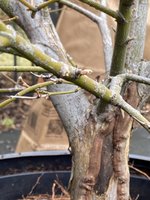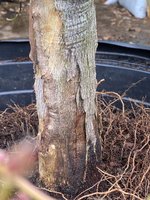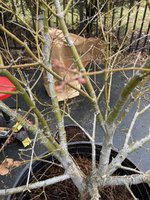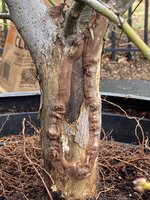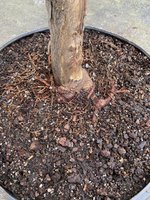When doing first development of tree best advice is give roots plenty of room. Shallower is likely OK, wider as well. Constricting roots during development phase not wisest course
This was my thinking as well, but I seem to have been corrected. I started a thread a few days back on the topic of ideal box size and the conclusion seems to be to fit the box to the root ball we are dealing with. Bigger isn't always better when we are dealing with pots (as opposed to ground growing). I've built boxes that have been called out for being too big for the tree in question as well as others that were too shallow for a training pot even though they are quite wide. Once we put a tree in a pot, issues of aeration, moisture etc. become more pronounced. At the risk of confusing the issue further, I have also been advised that using a pot far larger than the existing root ball may contribute to the formation of the wrong type of roots - that is, unless the tree already has a substantial mass of feeder roots, the tree may very well send out thicker roots to colonize the soil, only forming the feeder roots when the walls are reached. I have no first hand experience with this, but it makes sense that the tree would act opportunistically and grow giant roots.
For example, I have a 6 foot shishigashira that has a 7 inch base and 5 trunks in a 20 gallon nursery pot that I was planning on repotting into a 20X20X3.5" pot. Putting aside the sheer cost of the 6 gallons of soil that would be needed to fill it, I was warned that this box was simply too big for this absolutely massive tree.
Honestly not such hot advice for beginner.
For what it's worth, I too am a beginner and this has been the advice given to me repeatedly. Personally, I've never actually measured the root mass that I start with compared to what I cut off and, therefore, couldn't tell you an exact percentage. When I am ready to repot a nursery tree, I take it out of the pot, bare root it with a small rake and chopstick, cut off the entirety of the tap root and all downward growing roots, cut off oddly shaped radial roots and trim the radial roots down. The whole mass gets a sprinkle of rooting hormone and into bonsai soil it goes with a really heavy watering. I may even seal the cut of the tap root etc. if I'm in a mood. The nursery maples I've dealt with had no problem going from a basically root bound 5-10 gallon pot to a 14X14X3.5" box with room to spare for the roots to run. Going forward, I may increase the depth of the boxes I make to 5" so I can fill it a little more and also have room in the box for a layer of sphagnum moss in the summer months.
To be sure, I am an absolute newbie and still trying to iron these issues out in my head. I am expecting a few starter trees planted in 3 inch pots each of which I was going to repot into 18X12X3" Anderson flats. I am now re-thinking these plans under the notion that they are simply too big for the trees in question.


